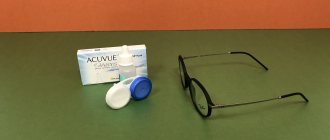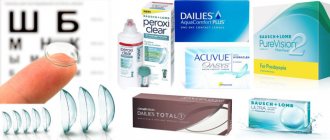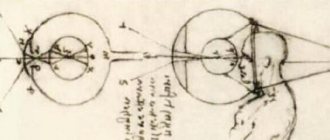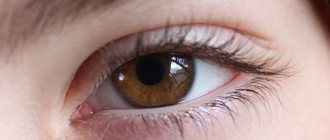What is presbyopia?
Presbyopia (age-related farsightedness) is a decrease in the eye's ability to focus on close objects. Its main symptom is a gradual deterioration in near visual acuity. With normal vision, presbyopia occurs at the age of 40-45 years, with myopia (myopia) - later, with hypermetropia - before 40 years, often accompanied by deterioration of distance vision.
A person suffering from farsightedness has trouble seeing objects up close, while at a distance he can see them without difficulty.
Of course, the question will arise: what to do? There are several options for solving the problem. You can choose two pairs of glasses: one for reading, the other for distance vision. You can use bifocals or progressive glasses. But if you lead an active lifestyle, then you are unlikely to be happy with such a decision. Contact lenses to correct presbyopia can help in this situation.
Rating
On the modern market you can find a lot of varieties of contact lenses from foreign and domestic manufacturers, which are designed to prevent refractive errors. The top 5 best include products from foreign companies.
Biofinity Multifocal
These are silicone hydrogel lenses that help eliminate all symptoms of presbyopia at various stages of the disease. This type is produced by Cooper Vision. When creating this type, a unique technology was used to create a material, thanks to which the lenses perfectly retain moisture and allow air to pass through, so wearing them throughout the day does not cause discomfort.
When creating the lenses, Aquaform technology was used - these are lenses with a low elastic modulus, which helps increase wearing comfort. You can wear this look for 7-30 days without taking it off. The price of the lenses is about 3000 rubles.
Dailies Aqua Multifocal
These are daily use lenses made by Alcon. These lenses have 3 optical ranges, all transitions are smooth, making it possible to achieve the most comfortable wearing and clear vision at any distance. This type has a special slightly rounded profile, which makes it easy and quick for even a beginner to put on lenses without being felt by the eye.
Also, when creating this type of lens, a well-thought-out humidification system was used, which is activated when blinking. The moisturizing agent is released gradually throughout the day. This type does not disrupt the stability of the tear film and does not cause dry eyes. The average cost of this type is from 2500 rubles.
Biotrue ONEday for Presbyopia
These are soft daily lenses for the correction of presbyopia - age-related farsightedness; they are made of biocompatible material - GyperGel, contain more than ¾ of water, due to which the cornea is constantly moisturized. The lenses allow sufficient oxygen to pass through.
The 3-layer progressive design guarantees clear binocular vision at any distance. With these lenses, a person can clearly see a mobile display, a computer screen, and objects on the street located at a distance. Lenses from the American manufacturer Bousch&Lomb will cost an average of 500 rubles.
PureVision Multi-Focal
This is another development of the American company Bousch&Lomb - high-quality silicone hydrogel lenses that require scheduled replacement only after 30 days. They help restore visual acuity at any distance - as close as possible or far away.
Unique aspherical design allows you to see clear images in twilight or dark conditions. The lenses allow air to pass through perfectly, do not dry out the mucous membranes of the eyes and do not cause discomfort during prolonged wear. The average cost of lenses is about 2500 rubles.
Proclear Multifocal
These are contact lenses with scheduled replacement after 30 days. Recommended for the correction of presbyopia. This disease is quite common among people over 40 years of age.
When creating the lenses, a unique Balanced Progressive™ technology was used, thanks to which a person is guaranteed clear vision at any distance. Humidifying technology creates a thin, breathable film of water that helps prevent dehydration and protects against the buildup of sediment and dirt.
The average cost of lenses is from 1900 rubles.
Purpose of multifocal lenses
In spectacle correction, progressive or multifocal spectacle lenses have long been used. Thanks to the smooth change in the optical power of the lens, in such glasses you can see well both far, near, and at intermediate distances. As a result, instead of two pairs of glasses (sometimes three), the patient has one pair of glasses for all occasions.
In recent years, the problem of presbyopia has become even easier to solve: with the help of contact multifocal lenses (another name is progressive lenses). Doctors successfully select them for patients who need correction of myopia or farsightedness combined with presbyopia.
The most popular brands of multifocal lenses from leading manufacturers:
- Air Optix Multifocal (CIBA Vision);
- Pure Vision Multi-focal (Bausch+Lomb).
These lenses are made from silicone hydrogel material with high oxygen permeability. Multifocal lenses have several zones with different optical powers, so they can clearly and clearly see objects located at different distances. Bifocal lenses are the simplest version of multifocal lenses. They have two optical zones, allowing you to view objects both near and far.
Useful video
You can also learn more about the operating features of multifocal lenses by watching the video.
Author's rating
Author of the article
Alexandrova O.M.
Articles written
2031
about the author
Was the article helpful?
Rate the material on a five-point scale!
( 1 ratings, average: 5.00 out of 5)
If you have any questions or want to share your opinion or experience, write a comment below.
Variable contact lenses
Variable bifocal lenses have a design similar to bifocal glasses: the upper part of the lens has a zone intended for distance vision, and the lower zone is used when viewing objects at a close distance.
The patient peering into the distance uses the upper part of the lens, and when reading or working with a computer, uses the lower part.
Such a lens must be strong and stable so that the optical zones do not shift. The stability of the lens is ensured by a small cut located at its very bottom. Due to this cut, the lens does not move when blinking, turning the eyes or head.
Application
Bifocal eye lenses can completely replace several pairs of glasses.
They are recommended to be used in several cases:
- initial degree of presbyopia;
- myopia up to -10;
- farsightedness up to +6;
- astigmatism up to 1.25;
- if lenses have already been fitted, but there are signs of blurred vision at close range;
- for contact correction.
Bifocal (multi) lenses also have contraindications:
- severe form of farsightedness and myopia;
- inflammation affecting the cornea and eyelids;
- glaucoma;
- drooping lower eyelid;
- increased dryness of the eye;
- decreased immunity;
- inability to get used to wearing this type of lenses;
- subluxation of the lens;
- low level of corneal sensitivity;
- taking certain types of medications.
Bifocal eye lenses are worn just like any other type.
They must be applied following the following algorithm of actions:
- Before inserting lenses, wash your hands thoroughly.
- Go to the dressing table or table, in front of which there is a large mirror.
- Disposable lens packaging should be checked for integrity. If no damage is found, then you can remove the lenses.
- To avoid confusion in the future when installing lenses, it is better to start with the same eye, for example, the right one.
- Place the lens on the pad of your index finger and check for damage.
- With the other hand, pull down the eyelid and look directly at the mirror. Place the lens exactly on the pupil and press slightly. If it doesn’t work, you can repeat the procedure.
- At first, it is better to remove your lenses at night, placing them in a special solution to give your eyes a rest. This applies mainly to those who are trying out wearing optical products for the first time.
It can be difficult for older people to place the lens correctly the first time. But don’t be upset, an ophthalmologist can help, who will help you carry out the procedure correctly.
Concentric contact lenses
These lenses alternate ring-shaped zones for near and far vision. Concentric bifocal lenses are a more advanced version of devices designed for vision correction. Their design depends on which zone is located in the center. In some lenses, the central zone for distant vision becomes central, and around it there is a ring zone for near vision, then these zones alternate. Other lenses have a reverse design: in the center there is a zone for close vision, and around it there is an area for viewing objects at a distant distance.
Typically, hard concentric lenses use the first option, and soft lenses use the second option. Sometimes the patient is given both options at once: a hard lens for one eye, a soft one for the other.
Rays of light entering the eye pass through all zones and participate in the formation of an image on the retina. It is noteworthy that the brain itself selects an image that allows it to form a clear visual image.
Aspheric contact lenses
The most modern are aspherical multifocal contact lenses. They are similar to progressive spectacle lenses: their optical power gradually changes, which ensures clear vision at different distances. In aspherical lenses, the central zone is usually dedicated to near vision. When a person looks at close objects, the pupil narrows, so the near zone should be located in the center of the lens.
When looking at distant objects, the pupils of the eyes dilate. The far vision zone located on the periphery becomes open and begins to function. The smooth change in optical power of aspherical lenses allows you to clearly see objects located at intermediate distances.
Concentric and aspherical contact lenses can rotate freely without compromising the quality of vision.
However, the patient needs time to get used to them. Multifocal lenses are absolutely not suitable for people who require greater addition (the difference between near and far vision).
Monovision as a way to correct presbyopia
Another method used to correct presbyopia is monovision. This technique involves the use of conventional spherical lenses: near vision is corrected for one eye, and distant vision is corrected for the other. But this method is not at all suitable for binocular vision: volume and depth can be perceived simultaneously only if the visual acuity of both eyes is almost the same and the patient looks at the object with both eyes. Monovision is categorically unacceptable for drivers of any vehicle.
Material of manufacture, mode of wearing, design – how to choose?
Fitting multifocal contact lenses will take longer than fitting regular single vision contact lenses. The user should understand that the first pair of lenses they try may not provide the desired quality of vision.
In this case, you will have to try another, and maybe a third pair. After selecting lenses, you need to come for a check-up in 5-6 days to make sure that the lenses fit.
Selecting multifocal contact lenses requires special knowledge and skills from a contact specialist, and you will have to pay for this service. However, the selection and manufacture of contact lenses themselves will not cost more than the selection and manufacture of good progressive glasses.
Today there are soft and hard bifocal and multifocal contact lenses.
Most of them are made from silicone hydrogel material, which has high moisture content (soft hydrophilic lenses) and oxygen transmission to the cornea (hard gas permeable lenses).
Depending on the wearing mode, multifocal lenses are distinguished:
- planned replacement (2 – 4 weeks);
- traditional (3 – 6 months);
- daily replacement lenses.
If you feel constantly tired or your vision has deteriorated, then it’s time to get checked for myopia.
Having your vision checked by an ophthalmologist for color vision will save your vision, remember this. Read more about this here.
Article about the destruction of the vitreous body:
How to choose
How do you know which lenses are right for a person? See an ophthalmologist. The doctor will suggest a correction remedy based on vision, eye characteristics and lifestyle.
Progressive correction means require a thorough examination by an ophthalmologist. The doctor eliminates contraindications and selects the best multifocal lenses, taking into account the individual’s characteristics. It takes into account:
- preferred replacement frequency – from daily to once a quarter;
- wearing mode corresponding to the client’s habits - only during the day or around the clock;
- degree of presbyopia;
- tendency to allergic reactions;
- the presence of concomitant ophthalmological diseases.
The choice is made individually and depends on the recommendations of the ophthalmologist, lifestyle and ease of use.
During the procedure, it is recommended to follow a number of rules:
- discuss the choice of CL in detail with the ophthalmologist who carries out the selection;
- It is necessary to visit a specialist several times so that he can prescribe a suitable model. Most often, 2-3 visits are enough;
- it takes time to adjust yourself to adapt; it takes time to get used to changing the focal length;
- If you experience discomfort, contact the specialist who performed the selection.
Multifocal lenses require consideration of certain features. If a person follows the doctor’s advice, then the adaptation period is easier and faster. Further use of the correction product will provide image clarity and visual comfort.
Recommendations for the selection of multifocal lenses and analysis of clinical cases in the video:
conclusions
So multifocal contact lenses are suitable:
- People who have previously successfully used contact lenses, but now find their vision blurred at close distances.
- Beginner presbyopes who have never worn contact lenses before.
- People who prefer contact correction to glasses.
- Nearsighted (up to -10.0 diopters) or farsighted patients (up to +6.0 diopters) with astigmatism no more than 0.75 diopters.
We remind you that multifocal contact lenses must be selected by a contact optician, who uses tables for selecting contact lenses. Before choosing lenses, the doctor will conduct the necessary examination, rule out contraindications for the use of contact lenses and recommend a design. And only then contact optics are selected with the desired wearing mode and replacement time.
Recommendations for selection
It is not advisable to select bifocal contact lenses for your eyes yourself.
It would be better if the selection is carried out by a specialist who will take into account all the most important parameters:
- Diameter and curvature of lenses. These parameters are determined individually so that a person does not feel pain or discomfort while wearing it.
- Structure and design. This type of lens, both for daily and long-term wear, can have different shapes and configurations. The most common is division into segments or in the form of concentric circles.
- The power of optics. You can choose lenses with different diopter values of optical zones. This choice depends on the nature and severity of the visual impairment.
- Hardness level. Depending on the complexity of the vision defect, you can choose soft or hard models.
- Duration of wearing. Some people prefer long-term wear models, while others prefer one-day ones.
When choosing, it is necessary to take into account not only visual impairments, but also the anatomical features of a particular person.
Bifocal (multi) lenses for the eyes are an ideal solution for people whose visual acuity decreases due to age-related changes in the body. The choice of lenses is huge, but it is better to entrust their selection to an ophthalmologist to eliminate all negative consequences.











